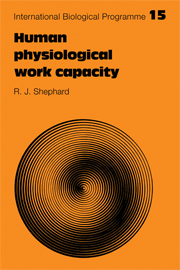Book contents
- Frontmatter
- Contents
- Foreword
- Preface
- 1 Introduction
- 2 Sampling and population studies
- 3 Methods for the measurement of physical fitness, working capacity and activity patterns
- 4 Climate, season and local geography
- 5 Socio-economic status and working capacity
- 6 Working capacity and constitution
- 7 The physical working capacity of the athlete
- 8 The growth of working capacity
- 9 Age and working capacity
- 10 Epilogue
- IBP Human Adaptability section publications
- References
- Index
7 - The physical working capacity of the athlete
Published online by Cambridge University Press: 20 May 2010
- Frontmatter
- Contents
- Foreword
- Preface
- 1 Introduction
- 2 Sampling and population studies
- 3 Methods for the measurement of physical fitness, working capacity and activity patterns
- 4 Climate, season and local geography
- 5 Socio-economic status and working capacity
- 6 Working capacity and constitution
- 7 The physical working capacity of the athlete
- 8 The growth of working capacity
- 9 Age and working capacity
- 10 Epilogue
- IBP Human Adaptability section publications
- References
- Index
Summary
One interesting feature of man's physical working capacity is that his potential for performance can be improved through appropriately chosen programmes of voluntary activity (‘physical training’). Gains realized in this way are largely independent of genetic and environmental considerations. A central objective of the IBP study of working capacity was to examine the full possible range of physical fitness in various societies. It thus became relevant to collect data on athletes, the extreme in the processes of selection and conditioning, contrasting such observations with results for the general metropolitan population – ‘ Homo sedentarius’.
The original IBP plans called for the testing of athletes in conjunction with the 1968 Olympic games. A fair number of measurements were made in Mexico City, but interpretation of the results was complicated by differences in adaptation to the test environment (both an altitude of 2240 m and a population of unfamiliar gastro-enteric micro-organisms). Many athletes and their coaches had irrational fears of altitude, training schedules were interrupted, and some participants were unwilling to give maximum endurance effort in close proximity to a major international contest.
Problems also arose from the specificity of athletic fitness. Unfortunately, many physiologists failed to distinguish either the level of competition or the class of event for which a competitor was prepared – for example, ‘swimmers’ included an amorphous amalgam of men participating in 100 m and 5000 m events, ‘soccer players’ were a mixture of wing forwards and goalkeepers, and ‘yachtsmen’ handled everything from a fourteen-foot dinghy to a seventy-foot schooner.
- Type
- Chapter
- Information
- Human Physiological Work Capacity , pp. 136 - 178Publisher: Cambridge University PressPrint publication year: 1978
- 1
- Cited by



